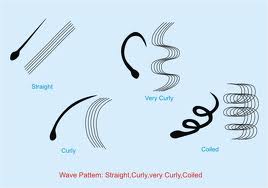|
I find that I found out more useful information by using the old fashioned way of analyzing and learning more about my hair type then using the classification system. Analyzing your hair is helpful when finding styling options, caring for your hair, and choosing the proper hair products. This involves understanding the following terms and really thinking about your hair and its behavior.
Texture
Texture refers to the diameter of each hair strand. The different hair textures include fine, medium, coarse. Fine hair is extremely soft and silky. It can often have difficulty holding a curl. Medium hair texture is the most common. There is a wide range of styling options for this hair type. Coarse hair has a rougher feel, is on the heavier side, and tends to grow both outwards and downwards from the scalp. I am just noticing my hair growing downwards as it has gotten longer. For a long time, it just grew out.
Density
Hair density refers to the number of strands in your hair. It is usually found by courting the number of strands in one square inch of the scalp and is unrelated to texture. It is often defined as thin, medium, or thick hair. Thin hair lacks volume and looks well with blunt cuts or styles with curls that give the illusion of volume. Medium hair is neither thick nor thin as the name suggests. Numerous styling options are available for medium hair and can include styling it to look thinner or boosting up the volume. Thick hair tends to have a lot of volume and looks great with layered styles. Density can also dictate which products we use. Often products will indicate if they give or minimize volume. Another thing to note is hair density decreases as we age, so styling options will have to be reconsidered.
Porosity
Hair porosity defines how well the hair absorbs moisture. Overly porous hair release moisture easily and is dry and easily damaged. Apple Cider Vinegar treatments work well to treat overly porous hair.
You can check the porosity of your hair by feeling it when dry. If it feels rough and tangles easily then it is overly porous. You can also test by taking a few strands of hair, one from the back, top and sides of your head, and dropping them in a bowl of water. If they sink in less than a minute or two, then your hair is overly porous.
Elasticity
This refers to how well the hair stretches and returns back to its normal state. Hair should be able to stretch up to 50% of its original length without breaking. You can test this by taking 4 strands of your hair from different sections while wet and stretching it to see if it returns to its original state without breaking.
Normal hair with high elasticity is easy to style and work with. Hair with low elasticity is more difficult to work with and has difficulty holding curls. If your hair is not “curly†as I often hear, it very well may be due to an elasticity problem. Over processing and excessive heat styling are common causes for low elasticity. The treatment I describe in my current monthly hair regimen is helpful in repairing elasticity.
Wave Pattern
Wave pattern just refers to the look of your hair. Hair can be straight, curly, very curly, or coiled. Healthy hair can have any of the patterns or even a combination of patterns in many cases. Hair with no wave is straight. Curly hair has a wave and forms a C or an S shape depending on length. Very curly hair has an S or a Z pattern and can be bushy when long. Coiled hair forms a spiral and grows out from the scalp. The spirals can be tiny or finger sized.
As you can see, hair is very complex. It is useful to analyze hair in order to choose perfect styling and product options. It also helps so that you are aware of any damage that needs to be repaired. It is essential to understand that hair types differ as much as individual personalities differ. You should work to understand what works best for YOUR hair. This is an ongoing process that will not be resolved easily.
|

